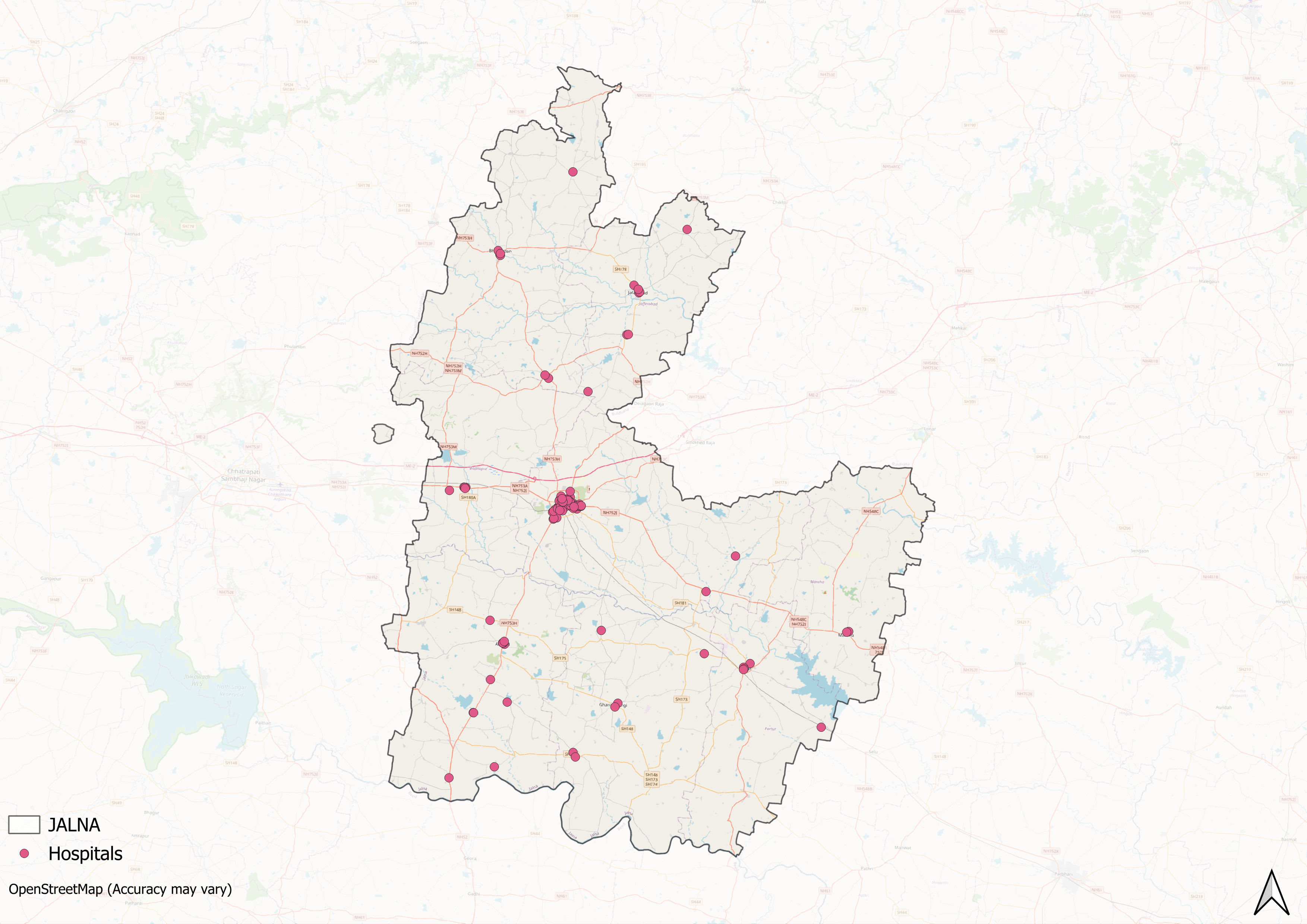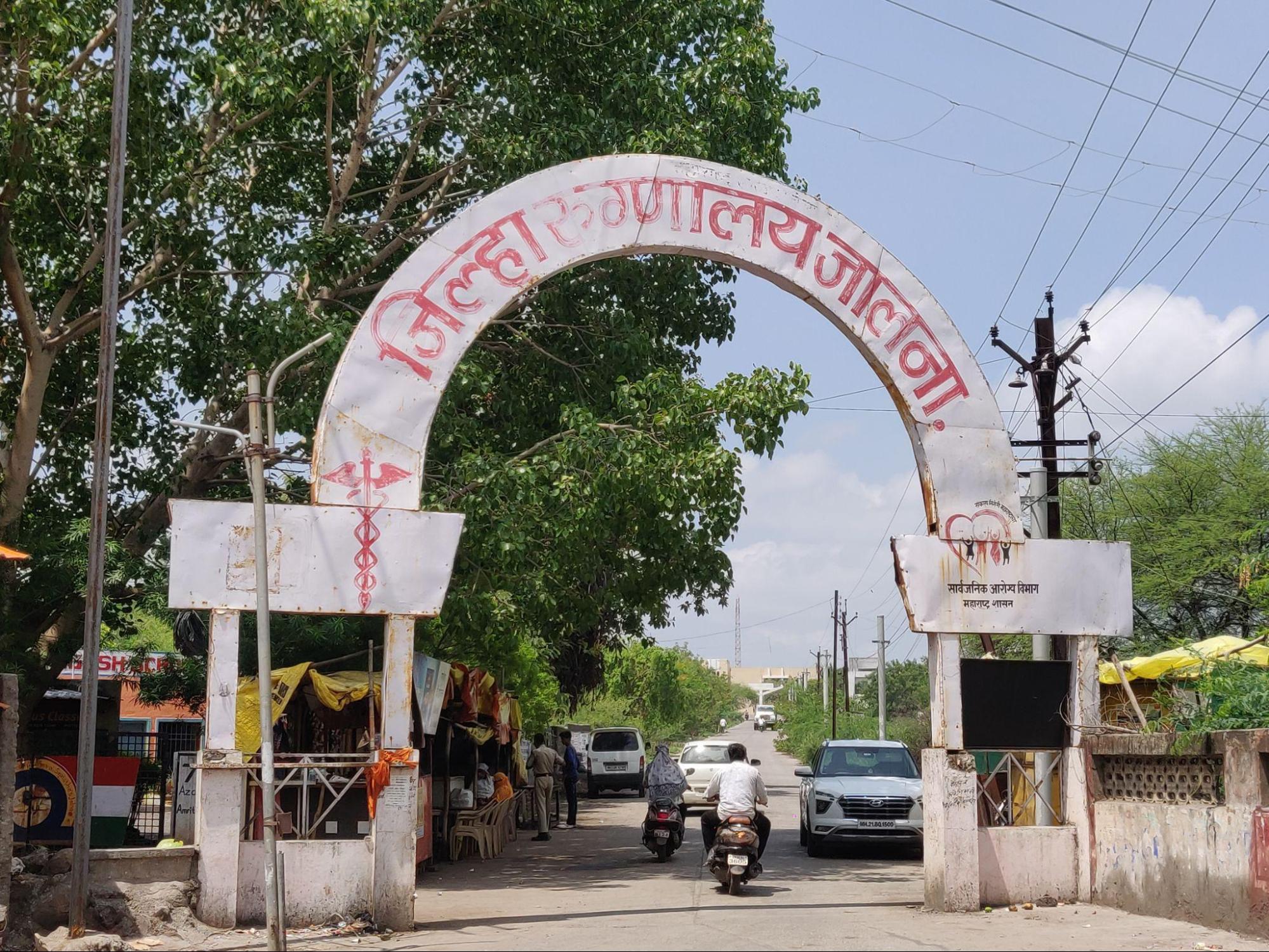Contents
- Healthcare Infrastructure
- Medical Education & Research
- Indian Institute of Medical Science & Research (IIMSR)
- Graphs
- Healthcare Facilities and Services
- A. Public and Govt-Aided Medical Facilities
- B. Private Healthcare Facilities
- C. Approved vs Working Anganwadi
- D. Anganwadi Building Types
- E. Anganwadi Workers
- F. Patients in In-Patients Department
- G. Patients in Outpatients Department
- H. Outpatient-to-Inpatient Ratio
- I. Patients Treated in Public Facilities
- J. Operations Conducted
- K. Hysterectomies Performed
- L. Share of Households with Access to Health Amenities
- Morbidity and Mortality
- A. Reported Deaths
- B. Cause of Death
- C. Reported Child and Infant Deaths
- D. Reported Infant Deaths
- E. Select Causes of Infant Death
- F. Number of Children Diseased
- G. Population with High Blood Sugar
- H. Population with Very High Blood Sugar
- I. Population with Mildly Elevated Blood Pressure
- J. Population with Moderately or Severely High Hypertension
- K. Women Examined for Cancer
- L. Alcohol and Tobacco Consumption
- Maternal and Newborn Health
- A. Reported Deliveries
- B. Institutional Births: Public vs Private
- C. Home Births: Skilled vs Non-Skilled Attendants
- D. Live Birth Rate
- E. Still Birth Rate
- F. Maternal Deaths
- G. Registered Births
- H. C-section Deliveries: Public vs Private
- I. Institutional Deliveries through C-Section
- J. Deliveries through C-Section: Public vs Private Facilities
- K. Reported Abortions
- L. Medical Terminations of Pregnancy: Public vs Private
- M. MTPs in Public Institutions before and after 12 Weeks
- N. Average Out of Pocket Expenditure per Delivery in Public Health Facilities
- O. Registrations for Antenatal Care
- P. Antenatal Care Registrations Done in First Trimester
- Q. Iron Folic Acid Consumption Among Pregnant Women
- R. Access to Postnatal Care from Health Personnel Within 2 Days of Delivery
- S. Children Breastfed within One Hour of Birth
- T. Children (6-23 months) Receiving an Adequate Diet
- U. Sex Ratio at Birth
- V. Births Registered with Civil Authority
- W. Institutional Deliveries through C-section
- X. C-section Deliveries: Public vs Private
- Family Planning
- A. Population Using Family Planning Methods
- B. Usage Rate of Select Family Planning Methods
- C. Sterilizations Conducted (Public vs Private Facilities)
- D. Vasectomies
- E. Tubectomies
- F. Contraceptives Distributed
- G. IUD Insertions: Public vs Private
- H. Female Sterilization Rate
- I. Women’s Unmet Need for Family Planning
- J. Fertile Couples in Family Welfare Programs
- K. Family Welfare Centers
- L. Progress of Family Welfare Programs
- Immunization
- A. Vaccinations under the Maternal and Childcare Program
- B. Infants Given the Oral Polio Vaccine
- C. Infants Given the Bacillus Calmette Guerin (BCG) Vaccine
- D. Infants Given Hepatitis Vaccine (Birth Dose)
- E. Infants Given the Pentavalent Vaccines
- F. Infants Given the Measles or Measles Rubella Vaccines
- G. Infants Given the Rotavirus Vaccines
- H. Fully Immunized Children
- I. Adverse Effects of Immunization
- J. Percentage of Children Fully Immunized
- K. Vaccination Rate (Children Aged 12 to 23 months)
- L. Children Primarily Vaccinated in (Public vs Private Health Facilities)
- Nutrition
- A. Children with Nutritional Deficits or Excess
- B. Population Overweight or Obese
- C. Population with Low BMI
- D. Prevalence of Anaemia
- E. Moderately Anaemic Women
- F. Women with Severe Anaemia being Treated at an Institution
- G. Malnourishment Among Infants in Anganwadis
- Sources
JALNA
Health
Last updated on 26 July 2025. Help us improve the information on this page by clicking on suggest edits or writing to us.
Jalna’s healthcare landscape, like many other regions across India, is shaped by a mix of indigenous and Western medical practices. For centuries, local healthcare was shaped by traditional practitioners such as vaidyas and hakims, who relied on indigenous knowledge systems and natural remedies. Over time, this foundation has been supplemented by the growth of formal healthcare institutions and the gradual introduction of specialised medical services across the district.
Healthcare Infrastructure
Much like other regions in India, Jalna’s healthcare infrastructure follows a multi-tiered system that involves both public and private sectors. The public healthcare system is structured into primary, secondary, and tertiary levels. Primary care is provided through Sub Centres and Primary Health Centres (PHCs), secondary care is managed by Community Health Centres (CHCs) and Sub-District hospitals, while tertiary care, the highest level, is delivered through Medical Colleges and District Hospitals.


Supporting this structure is a network of Accredited Social Health Activists (ASHAs) who, as described by the National Health Mission, serve as “an interface between the community and the public health system.” Over time, this multi-layered healthcare model has been continuously shaped and refined by national healthcare policies and reforms to provide universal health coverage across regions.
Jalna’s organised healthcare infrastructure, like much of India, has its origins in the colonial era, which laid the groundwork for the system in place today. Missionary initiatives during this time also played a significant role in shaping the region’s medical landscape. In fact, according to local accounts, the Church of Scotland Mission established Jalna’s first hospital, known as the Mission Hospital, in 1896. This hospital, operated by a charitable trust, continues to provide medical services to the community to this day.
Alongside these early efforts, state-supported health services gradually emerged. By the early 20th century, these included key institutions such as the District Civil Hospital (Zilla Rugnalay) and the Women’s Hospital. It is worth noting that Jalna was carved out as a separate district relatively late, in 1981, from Chhatrapati Sambhaji Nagar. As a result, the pace and pattern of institutional development in the area may have differed from older administrative districts.

In recent years, Jalna’s healthcare system has seen further expansion through efforts by local trusts, non-governmental organisations, government initiatives, and individual practitioners. In 2021, a portable hospital was introduced through a collaboration between Mastercard and the American India Foundation (AIF), adding temporary beds and ICU capacity in the district. Under the Mahatma Jyotiba Phule Jan Arogya Yojana (MJPJAY), around 22 private hospitals in Jalna have also received support to provide subsidised healthcare services.
The following year, in 2022, a Regional Mental Hospital was established in Jalna. It is important to note that public mental health services in Maharashtra have historically been limited, with only four regional mental hospitals serving the entire state for several decades. Hence, before this, Jalna, along with other districts in the Marathwada region, relied on the Regional Mental Hospital in Nagpur, which served a large area and was often overburdened. The new facility marked a significant shift in improving access to mental healthcare in the region.
Medical Education & Research
Medical education and research form an important part of Jalna’s healthcare system. As noted by Mathew Gerge (2023), medical institutions in India generally serve a “dual purpose” by training healthcare professionals and providing services to the local population. Both public and private institutions contribute to this sector.
Indian Institute of Medical Science & Research (IIMSR)
The Indian Institute of Medical Science & Research (IIMSR) is a private minority medical college located in Warudi, Badnapur taluka of Jalna district. Established in 2013, the institute is affiliated with the Maharashtra University of Health Sciences (MUHS) and is recognised by the National Medical Commission (NMC), formerly the Medical Council of India.
IIMSR was founded by the Jamia Islamia Ishaatul Uloom Trust under the leadership of Ghulam Mohammad Vastanvi. The institute offers an undergraduate program leading to the Bachelor of Medicine and Bachelor of Surgery (MBBS) degree. The program has a duration of 5.5 years, which includes a one-year mandatory internship.
Graphs
Healthcare Facilities and Services
Morbidity and Mortality
Maternal and Newborn Health
Family Planning
Immunization
Nutrition
Sources
Akram Khan, R.S. Pol, R. Nagarajan Gokhale. 2013-14. “Monitoring and Evaluation of Programme Implementation Plan, 2013-14 Jalna District, Maharashtra.”Population Research Centre, Gokhale Institute of Politics and Economics.https://gipe.ac.in/wp-content/uploads/2024/0…
ANI News. 2021. "Mastercard and American India Foundation (AIF) Launch First Portable Hospital in Jalna." ANI News.https://www.aninews.in/news/business/business/mastercard-and-american-india-foundation-aif-launch-first-portable-hospital-in-jalna20210727112915/https://www.aninews.in/news/business/busines…
Dr. Prachi Sharda. 2022. "Opening of Jalna Mental Hospital." LinkedIn. https://www.linkedin.com/posts/drprachis_ope…
M Choksi, B. Patil et al. 2016. Health systems in India.Vol 36 (Suppl 3). Journal of Perinatology. https://pmc.ncbi.nlm.nih.gov/articles/PMC5144115/https://pmc.ncbi.nlm.nih.gov/articles/PMC514…
National Health Mission (NHM). "About Accredited Social Health Activist (ASHA)." National Health Mission, India.https://nhm.gov.in/index1.php?lang=1&level=1…
PTI. 2023. "Private Hospitals in Jalna Rue Pending Dues Under Maharashtra Health Scheme." Business Standard. https://www.business-standard.com/india-news…
Steffy Thevar. 2022. "Maharashtra Has Only Four Government Mental Hospitals." Hindustan Times.https://www.hindustantimes.com/cities/pune-n…
Wikipedia Contributors. Indian Institute of Medical Science and Research. Wikipedia.https://en.wikipedia.org/wiki/Indian_Institu…
Last updated on 26 July 2025. Help us improve the information on this page by clicking on suggest edits or writing to us.